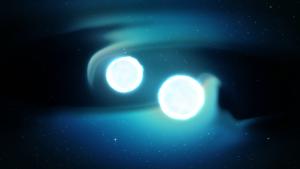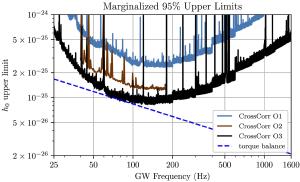Blog
The Song of Distant Mountains
5 January 2024
 NASA’s Goddard Space Flight Center/CI Lab
NASA’s Goddard Space Flight Center/CI LabThe surface gravity of a neutron star is so incredibly intense that it can cause atoms to collapse into a dense cluster of neutrons. The interiors of neutron stars may be dense enough to allow quarks to escape the bounds of nuclei. So it’s hard to imagine neutron stars as active bodies, with tectonic crusts and perhaps even mountains. But we have evidence to support this idea, and we could learn even more through gravitational waves.
One of the ways we know neutron stars are active is through pulsars. Pulsars are neutron stars that emit powerful beams of radio light from their magnetic poles. When those poles are aligned toward Earth, we see a regular series of pulses. The pulses are so regular that we can use them as a kind of cosmic clock, measuring everything from the orbital decay of binary systems due to gravitational radiation to the rippling of spacetime caused by the first moments of the Big Bang.
Because neutron stars radiate energy, their rate of rotation gradually slows down over time. It’s a small effect, but we can observe this slowdown in pulsar data. Sometimes, however, a pulsar will glitch, meaning that its rotation rate jumps up slightly. This can only happen if the shape of the neutron star has suddenly changed. Just as earthquakes can trigger a measurable change in the rotation of the Earth, starquakes change the rotation of neutron stars. So we know there is some kind of tectonic activity on neutron stars, but we aren’t entirely clear what that is.
One idea is that neutron stars have a rather thin but rigid crust, similar to that of a rocky planet. As a neutron star cools over time, this crust fractures and folds, which leads to quakes, fissures, and perhaps even mountains. While this seems to be a reasonable model, it’s difficult to prove because we can only detect a glitch when something dramatic happens. Imagine trying to study the mountains of Earth when you can only capture earthquake data. But as a paper on the arXiv shows, there could be another way to study the mountains of neutron stars: gravitational waves.1
Gravitational wave astronomy is still a young field, but it has already captured data from neutron stars. When neutron stars merge, they create an energetic burst of gravitational waves, similar to the way merging black holes emit a gravitational chirp. Astronomers have been able to combine gravitational wave observations of merging neutron stars with optical data to study the interiors of neutron stars. This new paper takes the idea one step further.
 Fabian Gittins (2024)
Fabian Gittins (2024)If a neutron star has a mountain or surface rise, it is asymmetrical. This means as it rotates the neutron star will emit a continuous stream of gravitational waves. These waves aren’t very intense, but they would hold lots of information about the overall shape of the neutron star. If we can observe these waves over time we could even study how a neutron star precesses due to the dynamic motion of its surface. For neutron stars with intense magnetic fields, known as magnetars, we could even study how the magnetic fields can distort the shape of a neutron star, which is something that may play a role in fast radio bursts.
Of course, to do all this, we need to be able to detect these faint gravitational waves, and here astronomers are a bit more sanguine. At the moment, the most precise gravitational wave data we have can only place an upper bound on the scale of neutron star mountains. Even then, all we can really say is that they aren’t huge, which we already knew based on glitch data. But as the next generation of gravitational observatories comes online, it could put us in the range of observation. There are still lots of challenges, but they don’t look insurmountable. So in the coming data, gravitational waves could revolutionize our understanding of neutron stars in much the same way as they are revolutionizing our understanding of black holes today.
Gittins, Fabian. “Gravitational waves from neutron-star mountains.” arXiv preprint arXiv:2401.01670 (2023). ↩︎